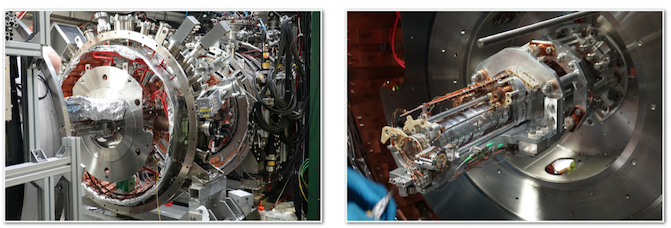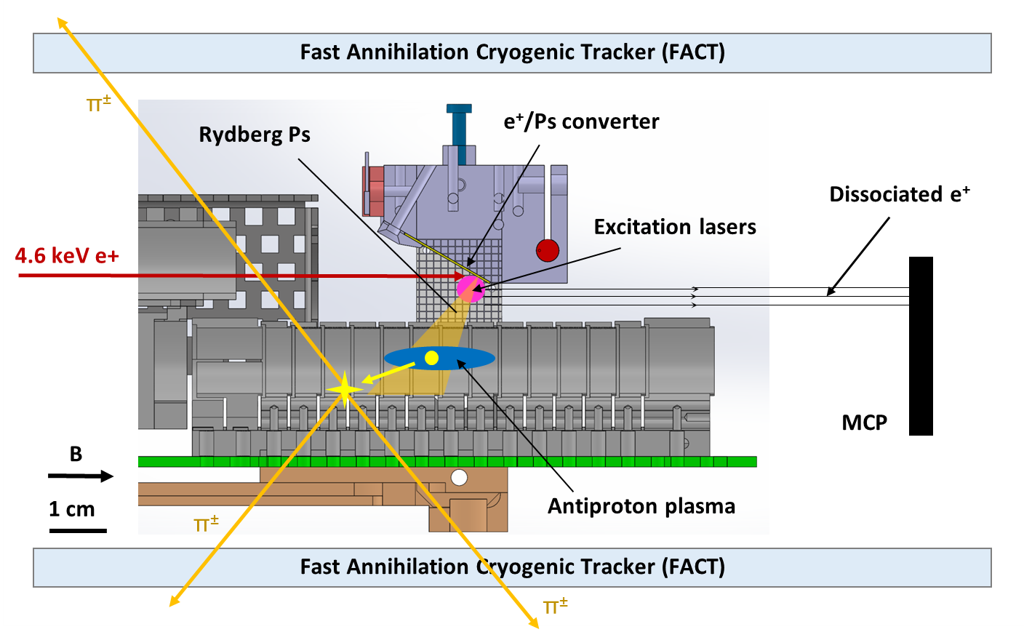Since 2020, AEgIS underwent a series of hardware and software upgrades, with the goal of increasing our antihydrogen production rate and to transport our antiatoms outside the main magnetic field used to confine its constituents prior to formation, antiprotons and positrons. Now the experiment can rely on a fully automated and fail-safe experimental setup, with which the team has set a record of 3.7 million trapped antiprotons. AEgIS aims at increasing the rate of production of antihydrogen by a factor of 100 in this upgraded configuration. Following that, shaping a pulsed beam of antihydrogen atoms and bringing them outside the magnetic field will be possible, with the benefit of removing magnetic disturbances to gravity measurements. AEgIS aims at the first measurements of the gravitational pull on antihydrogen atoms clear of magnetic effects in the next few years.

Central part of the AEgIS apparatus: Our 5T solenoid magnet is visible on the outside. In the center is placed the Penning-Malmberg trap, in which a cold mixture of negative atomic ions and antiprotons can be held.
Generating such exotic bound states of matter and antimatter is not a simple task. It requires a very careful combination of knowledge and expertise from different branches of science and the use of the globally unique research infrastructure of the Antimatter Factory at the "European Organisation for Nuclear Research (CERN)".
AEgIS pioneered its method to produce 100-nanosecond-long pulses of antihydrogen atoms between 2017 and 2020. A cloud of positronium (Ps) atoms in highly excited states was directed towards a cloud of cold, trapped antiprotons from the AD, and from their collision, cold antihydrogen atoms were formed. Antihydrogen atoms, being neutral, can escape from the trap made for charged antiprotons, and quickly hit the trap walls annihilating. A good fraction of the resulting annihilation products travel several meters before being stopped by materials, and allow detecting annihilation events by standard particle detectors. Take a look to our article "Pulsed production of antihydrogen" for all the details about this milestone result.

The original scheme of AEgIS to create a pulsed source of antihydrogen.
AEgIS was constructed and commissioned between 2012 and 2016. In particular, a key element to this commissioning were the complex particle traps used to confine antiparticles, antiprotons and positrons. A complex system of electrodes is used to confine the particles axially with electric potentials, whereas a strong magnetic field generated by a superconducting solenoid provides the so-called radial confinement: charged particles are forced to spiral around magnetic field lines in a never ending motion called cyclotron motion, impeding them to hit on the particle trap walls. These traps are held at cryogenic temperature, just 10 degrees above absolute zero, in a ultra-high vacuum condition. Vacua are so good that AEgIS cannot measure it with commercial devices: we determine it indirectly by the life time of antiprotons in our traps!
In the mid-2000s, the ATHENA experiment at CERN was coming to a close, having successfully created cold (i.e. slow) anti-hydrogen atoms for the very first time. Still, there was much research on antimatter left to do. From ATHENA came two new experiments with two different main goals. One of these experiments is the Antimatter Experiment: Gravity, Interferometry, and Spectroscopy, or AEgIS, as a nod back to its predecessor ATHENA. It seeks to measure the effects of Earth's gravitational pull on antimatter in the absence of a magnetic field.
In 2008, CERN officially accepted AEgIS as an experiment. From there, AEgIS went along the path to studying the effects of gravity on antihydrogen. One major issue faced so far is the efficiency of antihydrogen production. It has been what much of the research AEgIS has done so far and started in Phase 1 of their research, to effectively use the charge exchange reaction to make a pulsed beam of anti-hydrogen. Previously, antihydrogen could only be produced in a process known as mixing, where antiprotons and positrons are put together in a space, mixed around with magnetic and electric fields. Soon the particles stick together as antihydrogen atoms, and the physicists can explore do their observations. Because AEgIS measures gravity's effects on these antimatter particles, there must be a consistent direction for the particles to travel. The experiment has implemented a technique to make a more controlled and efficient source of antihydrogen, which is known as the charge exchange reaction.

The charge exchange reaction that forms antihydrogen.
